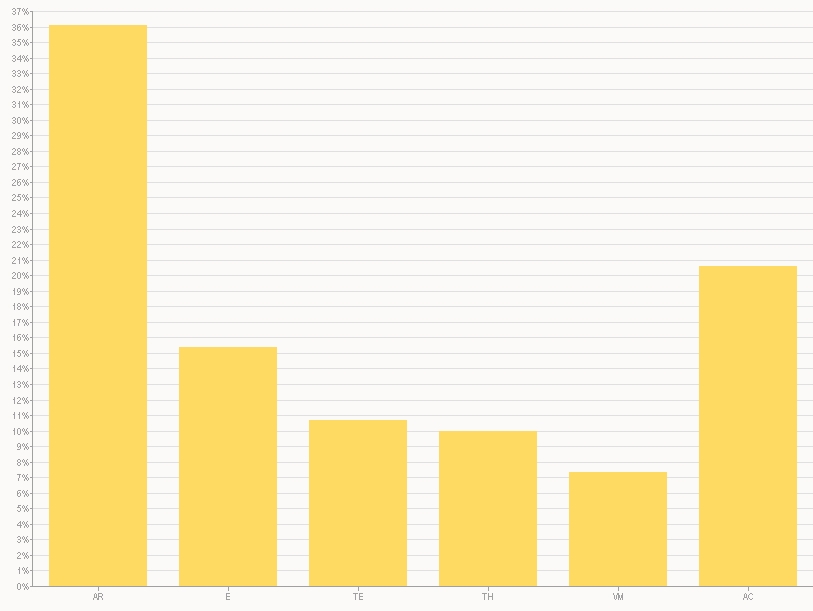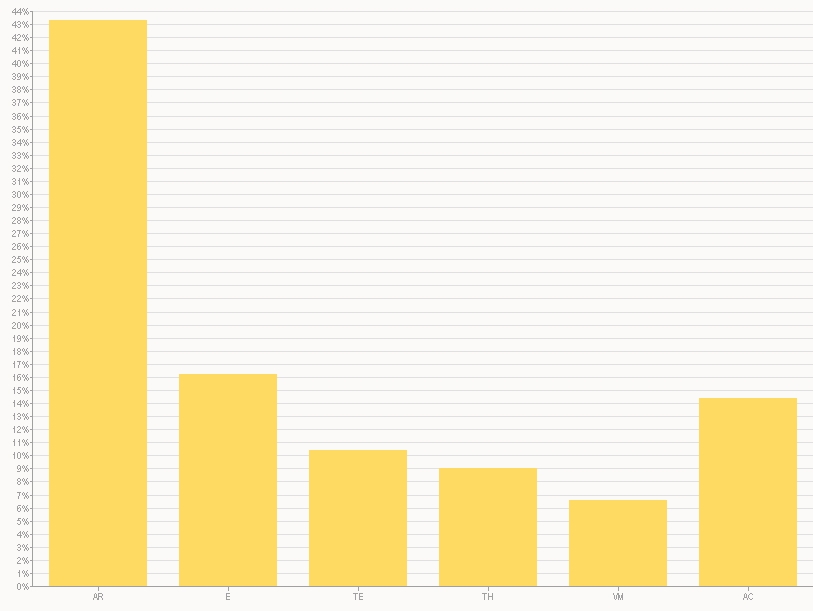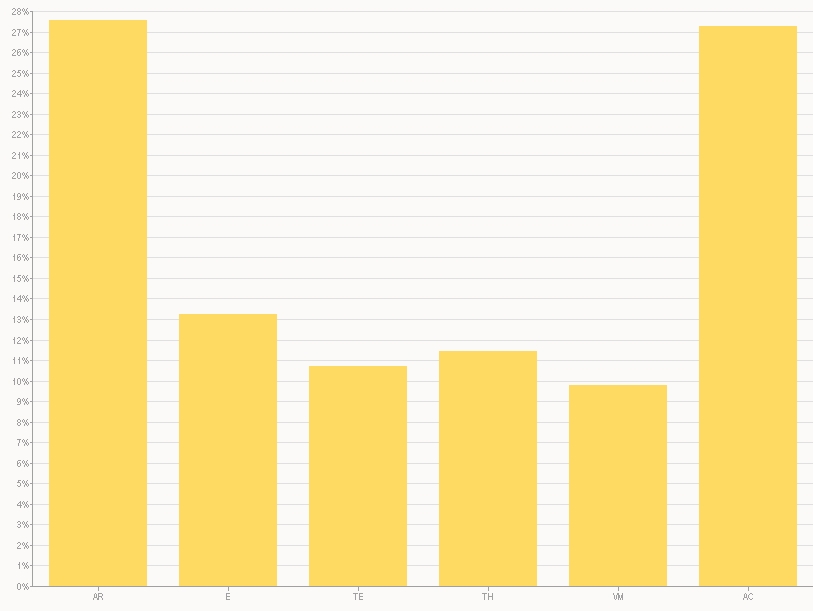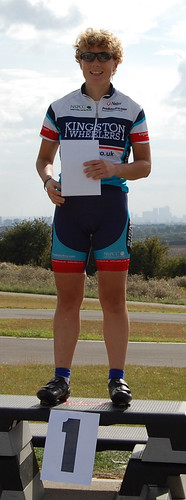The make-up of each group varies from night to night (Keith has a good memory for names, faces and abilities!) but usually the first group to go consists of new 4th cats, ladies and 4th vets. The second group has weaker 3rd cats, 3rd vets and more experienced 4ths and ladies, the third group has the stronger 3rd cats, the fourth group is the 2nd cats, and the scratch (last) group contains all the elites and 1st cats. The groups are set off in order with gaps of up to several minutes between, meaning each group has to try both to catch the groups in front and stay ahead of the groups behind. On any given night, nobody knows how generous the handicaps will be, who will work together well enough to stay away, or how long it will take to be caught by the groups behind. Makes for some very interesting racing!
Tactics are basic but ruthless: the faster groups try to sprint past when catching the slower groups to prevent anybody from jumping on the train, while the slower groups try desperately to latch on and keep going. Within each group, it's an unspoken agreement to work together, but sandbaggers can expect to be attacked. Groups are often as small as eight riders. With nowhere to hide, and everyone with a vested interest to work together to catch/keep from the other groups, it's one of those "push your limits or get dropped" kind of races. Just what some of us need to get in a great night's training, as I could certainly never ride 30 miles so hard on my own the way I can in a handicap.
What's interesting about handicap races on the open road -- where you often can't see a group you're catching until mere minutes before you catch them -- is how little shelter it offers the rider who's used to hiding in a 60+ rider bunch. In the early laps, most people will come through and take a turn on the front, but as the laps pass and legs tire, often it's down to only a handful of riders doing all the work while the rest are doing their best to conserve energy and hang on. Sharp corners, rolling hills, accelerations as other groups come past and unexpected gaps opening up all contribute to that stretching elastic effect til suddenly you look around and realise that half the group you started with is off the back. This is when some riders are confronted with the brutal truth that a good Surrey League handicap race exposes: just because you can finish in the bunch at Hillingdon week after week doesn't mean you're a strong rider! In fact, I would say that not only are handicaps a much better way to use racing as training, they are a good test of true fitness. And they will expose your weaknesses in racing like nothing else.
To illustrate my point, here are a few diagrams taken from WKO+ from recent men's races I've done. The first is Hillingdon during the winter series, a 3rd cat men's race. The second is Goodwood, a pan-flat windy circuit, also a 3rd cat men's race. And the third is last night's handicap at Accommodation Rd. out by Longcross. All three races I felt that I put in some effort, but was still well within myself. Note how much less time is spent essentially freewheeling in the handicap, and how much more time is spent sprinting and at VO2max level!

Hillingdon, January 2 2010

Goodwood, March 28 2010

Accommodation Road handicap, May 13 2010
Oh yes, a race report!
In last night's race I started in the second group and it was quickly apparent that I was one of a handful of stronger riders in the group. We worked together reasonably well but it was only two laps before we were caught by Jim's group (the third group), who had quickly pared themselves from ten to four riders by the time they caught us. Most of my group managed to latch on, though the speed had now increased and some people (who had already disappeared from the front a lap before) were struggling. They got some respite as we caught the leading group on the road of 4th cats, many of whom also managed to join the back of our group thanks to a car that slowed us at the wrong moment. A lap went by, then an attack at the front saw the group split briefly at the corner-plus-draggy-hill section and I was on the wrong side of it. But seeing Jim and fellow KWer Damien in the group ahead, I was content to let them go and not chase -- especially when nobody came around me to help!
We caught them back up by the next corner after the downhill though, and it stayed that way for another half-lap until the scratch group came steaming through, which included a strong rider in Jim's original group who had been caught napping when the four of them had attacked. The acceleration from the scratch group saw most of my original group and all of the 4th cats dropped, with only four of us left (not coincidentally the four who had been taking the most turns before being caught by Jim's group). I looked around and realised I was the caboose on the train, and though I knew I needed to move up the line of riders, with the tailwind and speed I just couldn't and sadly hit the next corner still at the back. I tried desperately to come out of the corner and hit the hill hard, but as that was the prime attack spot on the circuit, attack they did and off the back I went. As I did, I overtook two riders from my original group as they blew themselves up trying to stay in touch, and ended up 100 yards behind the main group -- now the front group on the road -- as they rode away.
The last guy left from my original group joined me and we worked together to try and stay away from whoever was left behind us, which we managed for another lap and a half. Then just as we hit the bell lap, the rest of the scratch and 2nd/3rd cat riders who had been dropped from those groups earlier on caught us up and I spent the final lap in a group of a dozen riders again. On the final hill to the finish, I managed to come around a few of them who either gave up or blew up and I ended around 20th or so. Not bad for an evening's training! Damien ended up in the points at 8th and Jim 11th, while former Wheeler Luke was 5th.
Below is the hardest lap out of the eight we did, lap 3 when Jim's group joined us. Note my FTP at 235 and how I spent much of the time above it! My peak 1-sec, 5-sec, 10-sec, 2-min, 5-min and 10-min were all in this lap.

The hardest lap
Lap 3 (0:09:04.04):
Duration: 9:03
Work: 119 kJ
TSS: 16.5 (intensity factor 1.045)
Norm Power: 245
VI: 1.12
Pw:HR: -11.92%
Pa:HR: 10.83%
Distance: 6.011 km
Elevation Gain: 84 m
Elevation Loss: 84 m
Grade: -0.0 % (0 m)
Min Max Avg
Power: 0 741 219 watts
Heart Rate: 154 184 175 bpm
Cadence: 31 159 101 rpm
Speed: 16.9 68.6 39.9 kph
Altitude: 35 72 52 m
Crank Torque: 0 87.9 20.3 N-m
Entire Race
Duration: 1:16:51 (1:17:41)
Work: 951 kJ
TSS: 123.7 (intensity factor 0.983)
Norm Power: 231
VI: 1.12
Pw:HR: 5.35%
Pa:HR: 1.49%
Distance: 48.081 km
Elevation Gain: 666 m
Elevation Loss: 665 m
Grade: 0.0 % (0 m)
Min Max Avg
Power: 0 741 206 watts
Heart Rate: 85 184 170 bpm
Cadence: 31 196 99 rpm
Speed: 4.5 69.6 37.5 kph
Altitude: 35 72 52 m
Crank Torque: 0 87.9 19.6 N-m

No comments:
Post a Comment